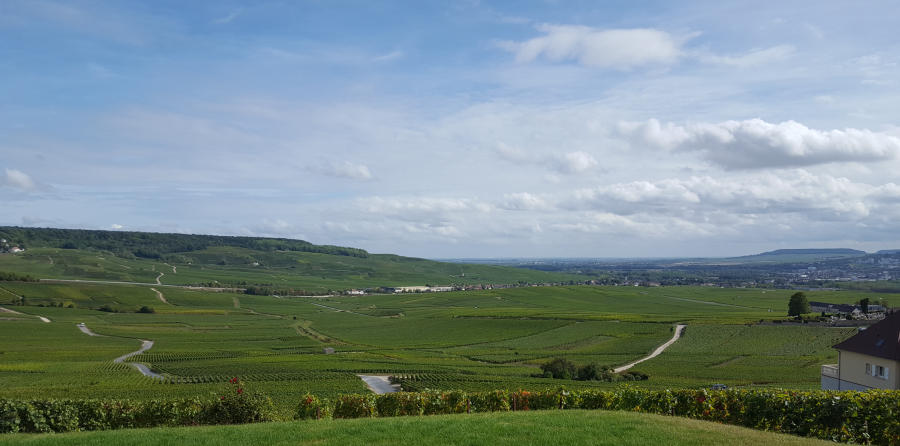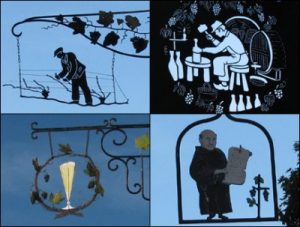
This article provides an overview of the Champagne region for travelers looking to visit its winegrowing zones over the course of a day or two or three. It partially echoes another article on this site, A Champagne Diary: 3 Grapes, 3 Lunches, 3 Dinners, a Bit of Chocolate, and Countless Bubbles, which indicates a number of worthwhile restaurant options in the region.
***
No wine is more evocative than Champagne, the king of sparkling wines. Yet Champagne is so readily associated with romance, celebration, name brands, and high living that we tend to forget that beyond being wine it’s a region in northeast France.
Champagne is in fact an earthy product, and the best way to get to know it is to visit the very earth, vineyards, and cellars where it’s produce, some 90 to 110 miles east of Paris. That’s close enough that you can enjoy a glimpse and a taste of Champagne in a daytrip from the French capital, though an overnight or two-night stay allows for more thorough explorations. Or three nights if you’re on a mission, as I was in late September, when, as the last grapes were being brought in from the harvest, four English journalists, a Canadian journalist, and I set out for a serious taste of Champagne.
Our mission was to get a well-rounded view of all that goes into producing and enjoying Champagne while keeping in mind the mantra “drink the wine, not the label.” That’s a wise approach with respect to any wine, and nowhere more important than Champagne. It’s an approach that led us to visit towns and villages, vineyards, grapes, cellars, facilities, Champagne houses great and small, and meet with the variety of individuals involved in the process. Along the way, we discovered the variety of the wine as well as of the region.
There is no one way to visit Champagne, but however you do, whether for one day or for three, you’ll soon learn that three important facets of production define the taste and quality of the final product:
1. the quality of the grapes,
2. the percentage in the final blend of the three main grape varieties authorized in the production of Champagne: Pinot Noir, Pinot Meunier, and Chardonnay,
3. the dosage of sugar and liqueur that is added (or in rare cases not) to a bottle after its second fermentation.
Here are various places in Champagne where you can learn those details and much more about Champagne, both the wine and the region.
Reims
The two main towns for Champagne production in the region are Reims and Epernay, located respectively north and south of the Mountain of Reims, which is the central grape-growing zone in the region. Both Reims and Epernay can rightfully stake a claim to being the centerpiece of Champagne explorations since the major houses are headquartered at one or the other.
For an overnight, you might include both, but on a daytrip I’d opt for Reims over Epernay for two reasons: Reims requires less planning due to the frequency of high-speed trains to and from Paris (45 minutes each way) and it offer s a strong dose of historical splendor with its bubbly.
The hit parade of Champagne houses in Reims include G.H. Mumm, Taitinger, Pommery, Piper-Heidsieck Lanson, Veuve Clicquot, Ruinart, and others, so you’re at no loss for cellar and production tours to choose from during the day. (See the link to the Reims Tourist Office below for further touring information.) Meanwhile, the history of Reims goes both deep and high: deep in that some of the Champagne cellars originated as Roman limestone quarries (a triumphal arch from the 3rd century is the main remnant of Reims’s development as a Roman city); high in that the city rightfully boasts one of the greatest of all Gothic cathedrals, Notre-Dame de Reims, built largely in the 13th century, and a magnificent basilica, Saint Remi de Reims, that was started in the 11th century. The smiling angel on the cathedral (see photo) may have begun as a religious symbol but is now often seen as a wink to the pleasures of drinking Champagne in Reims.
Epernay
Epernay and its surroundings live, breath, and eat—well, drink—Champagne. There’s little in the way of historical distraction here, other than the history of sparkling wine. Champagne is Epernay’s raison d’etre. Its central thoroughfare, Champagne Avenue, is the Rodeo Drive of the big brand bubbly, including Moet & Chandon, Mercier, Martel, De Castellane, Boizel, Demoiselle, Pol Roger, De Venoge, and Perrier-Jouet, many of which offer tours year-round. (See the link to the Epernay Tourist Office below for further touring information.)
The major Champagne houses in Epernay and Reims offer tours that are at once informative and promotional. Yet I found during our three-day mission that trying Champagnes from various producers using different blends was the best way to get to know the variety of sparkling wines in the region.
Epernay has an enjoyable concept bar (and wine shop) called C Comme where you can do just and with little effort. The originality of the bar is that you can order a series of small glasses of Champagne selected to give a sense of the different grape varieties or blends available, i.e. 100% Chardonnay (a.k.a. Blanc de Blancs) vs. 50% Chardonnay/50% Pinot Noir vs. 40% Chardonnay/30% Pinot Noir/30% Pinot Meunier. The Champagnes of different producers will naturally have a different taste even at similar percentages, partly due to the sugar-liqueur dosage added, nevertheless, tasting by blend rather than by brand gives an excellent sense of the range of possibilities.
Hautvillers
 Hautvillers is among the most charming Champagne-producing villages, as well as one of the most historically significant. Located 4½ miles from Epernay and overlooking a wide sweep of vineyards along the slopes of the Mountain of Reims, the village earns its place in history because it was here, at the Benedictine Abbey of Hautvillers, that the monk Dom Pierre Perignon (1639-1715) worked as cellar master.
Hautvillers is among the most charming Champagne-producing villages, as well as one of the most historically significant. Located 4½ miles from Epernay and overlooking a wide sweep of vineyards along the slopes of the Mountain of Reims, the village earns its place in history because it was here, at the Benedictine Abbey of Hautvillers, that the monk Dom Pierre Perignon (1639-1715) worked as cellar master.
Though vines had been thriving in the Champagne region since Roman times, mastering the natural effervescence of local wines and controlling the double fermentation that tends to take place in northern climes began in the 17th century, thanks in part due to curiosity and efforts of Dom Perignon. Assembling wines from different years and different kinds of grapes, he and other cellar masters at the time developed cork-popping Champagne as we know it today. That connection leads Hautvillers to call itself “the cradle of Champagne.”
Dom Perignon is well known as a trademark for a high-end Champagne, but we’re talking here about the wine, not the label. Dom Perignon is entombed in the abbey church at Hautvillers beside Dom Ruinart, another monk-cum-trademark.
With an annual production of about 300 million bottles, Champagne is naturally big business dominated by the dozen or so major Champagne houses, themselves mostly belonging to large luxury groups. Yet many of the Champagne vineyards themselves belong to individual families, who either sell their grapes to the large houses, produce Champagne as a cooperative, or produce their own Champagne. Thus the interest of visiting the small producers whose sparking wine isn’t exported, such as G. Tribaut in Hautvillers, where a sunny day, a view over the vineyards, and a varied tasting provided us with a very cheery aperitif.
Further afield
Tourist offices in Epernay and Reims provide outlines of Champagne Routes in the surrounding areas. With sufficient time, your own Champagne mission will ideally lead you to examine small, medium, and large producers in various parts of the region, including those further afield from the main Champagne routes around the Mountain of Reims. As at home, drinking and driving is a non-non.
Our own mission, which included a designated driver, took us to Châlons-en-Champagne. While Reims has the feel of a capital city, the regional capital is in fact the pleasant but less striking town of Châlons. There’s a monstrous cathedral, an easy-going riverboat tour, a touch of American history (the American Unknown Soldier was selected at City Hall following WWI)… and a Champagne house.
Though removed from the current growing zone for grapes that go into Champagne, we made the detour to Châlons to visit the medium-sized Champagne house Joseph Perrier. Founded in 1825, Joseph Perrier produces about 800,000 bottles per year, many of which are kept in Roman limestone quarries dug into the hill above the head office. It’s an example of a type of Champagne house that you might visit by appointment.
We also headed to the southern-most vineyards in the region planted in the south of the region whose planting zone is called the Cotes-des-Bar. That’s where we visited Drappier, another medium-size Champagne house with an annual production of about 1.6 million bottles.
After visiting the cellars, portions of which were dug out by Cistercian monks in 1152, we tried several of the house’s Champagne including a 100% Pinot Noir “brut nature,” which is dryer than most Champagnes in that the sugar-liqueur that is typically added in varying doses to sparking wines is absent. I liked its dryness, though in our group found it too dry.
Throughout our stay, each one of us discovered his or her individual preferences with respect to Champagne. Some liked it sweet, some like it dry, some liked it more Chardonnay or more Pinot Noir, … some just liked drinking. After three days, more than a dozen brands, and sometimes several types within those brands, some of the mystery of Champagne may be gone, but it’s for me it’s even more evocative, as it calls to mind both a sparkling wine and a brilliant travel experience.
Useful links and information
April though October offers the possibility of the nicest weather for a visit to Champagne but visiting at any time of year allows you to learn about the region’s sparkling wines and to get a sense of its history and landscape.
Champagne-Ardenne Tourist Board: www.tourisme-champagne-ardenne.com. Though I’ve referred to the Champagne region throughout this article, the administrative region is actually called Champagne-Ardenne as it also comprises the area in and around the hills and forests of the Ardennes along the Belgian border.
Reims Tourist Office: www.reims-tourisme.com.
Epernay Tourist Office: www.ot-epernay.fr.
Hautvillers Tourist Office: www.hautvillers.fr.
Châlons-en-Champagne Tourist Office: www.chalons-tourisme.com.
C Comme (wine bar and shop in Epernay): www.c-comme.fr. Open daily.
Champagne G. Tribaut (Champagne house in Hautvillers): www.champagne.g.tribaut.com.
Champagne Joseph Perrier (Champagne house in Châlons-en-Champagne): www.joseph-perrier.com.
Champagne Drappier (Champagne house in Urville, Côte-des-Bars): www.champagne-drappier.com.
© 2009, Gary Lee Kraut
This article first appeared in Jan./Feb. 2010 issue of Travelworld International Magazine under the title “Champagne: A Sparkling Wine in a Dazzling Region.”

